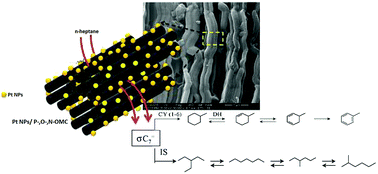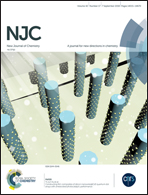Synthesis and functionalization of ordered mesoporous carbons supported Pt nanoparticles for hydroconversion of n-heptane†
Abstract
A comprehensive study was performed on the spectroscopic and textural properties of ordered mesoporous carbon (OMC) of the CMK-3 type modified by acid oxidation using K2S2O8 as a benign oxidant and nitrogen-doping by the aid of the polymerization of ethylenediamine and carbon tetrachloride inside the pore channels of SBA-15 hard template. The pristine, nitrogen-doped, and oxidized-ordered mesoporous carbons were used as supports to prepare 10 wt% platinum nanoparticles-loaded catalysts using ethylene glycol as a reducing agent. The catalytic behavior, mechanism, and influence of the surface functionalization of the ordered mesoporous carbon bifunctional catalysts toward the hydroconversion of n-heptane using a fixed-bed flow system operated under atmospheric pressure were investigated. The synthesized samples were characterized by various analytical and spectroscopic techniques. The mesostructural regularity corresponding to the hexagonal P6mm symmetry of the OMC-CMK-3 type was well-reserved even after surface modifications replicated from an SBA-15 template. H2 pulse chemisorption and EDX mapping images confirmed differences in the Pt NPs contents and dispersion depending on the support composition. The catalytic activity results achieved were hand in hand with the proper balance between the acidity strength and Pt NPs dispersion degree.



 Please wait while we load your content...
Please wait while we load your content...